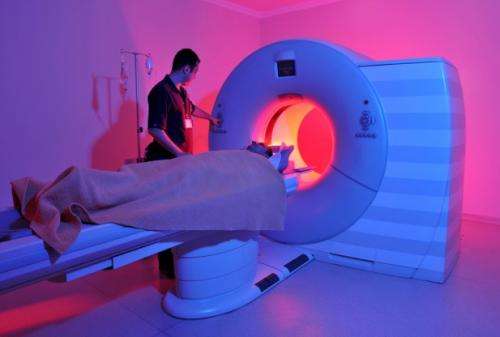March 21, 2013 report
MRI Fingerprinting: the 12-second scan and a whole lot more

(Medical Xpress)—Getting an MRI can be an uncomfortable experience, particularly for a 40-minute or longer scan. In the US at least, it is also quite expensive—the same kind of scan costing just over $100 in France, for example, would undoubtedly cost over $1000 here. If the whole scan could be done in say, 12 seconds, the call to "make the patient the customer again" might be heard a little clearer. A new technique developed by a collaborative effort at Case Western University and Siemens, known as MRI Fingerprinting (MRF), promises to do just that. The team's findings are described in the recent issue of the journal Nature.
While MRI is in principle a quantitative instrument, in practice, the results are typically best described as qualitative. If it were really quantitative, caregivers would probably discuss features of the scan more in terms of absolutes, ideally suffixed with appropriate units. Instead, we usually settle for the familiar, regions of hyper, or hypointensity to describe regions of anomaly.
MRF would be performed using the standard MRI hardware, but it draws on a set of new signal processing techniques falling under the rubric of compressive sampling. Engineers have been hammering out a novel approach to a broad class of problems arising in everything from telecommunications, to image acquisition and processing. Most recently in medicine, compressive sampling, or random sampling as it is sometimes called, has been applied to create high resolution endoscopic images.
To analogize how these new methods might actually work, let's imagine acquiring a natural image. It can be shown that if the image is acquired through a psuedo-random mask of sorts, much greater efficiency can generally be achieved. Intuitively we might expect that if the first 300 pixels of a seascape, for example, are all highly correlated blue sky, perhaps structuring the pixel acquisition in some other way could be more efficient.
The metaphor is obviously a simplification, but the key for MRF is rather than using rigidly defined and error-prone scans on the front end, all the data can be acquired up front using compressive sampling. Afterwards, pattern recognition techniques can be used in the post processing. While the fingerprint is not to be understood literally as a kind of DNA fingerprinting as used in forensic science, the process resembles matching a person's fingerprint to a database that can then draw up additional related information.
Following acquisition of the imaging data, a so-called "dictionary" containing the realistic range of standard MRI parameters (like relaxation times and off-resonance frequency) can be obtained with relatively modest computing resource. Other properties often obtained from MRI data such as diffusion and magnetization transfer can also be measured. These are the parameters behind the techniques now at our disposal for tracing the paths of axon tracts in the brain, in particular diffusion tractoctagraphy.
The authors of the study conclude that in using MRF, the traditional imaging routine will be greatly simplified into an all-in-one scan. The dozens of parameters under operator control in current MRI machines could be replaced with a simple scan button, making MRI more routine, patient-friendly, and affordable.
More information: Magnetic resonance fingerprinting, Nature 495, 187–192 (14 March 2013) doi:10.1038/nature11971
Abstract
Magnetic resonance is an exceptionally powerful and versatile measurement technique. The basic structure of a magnetic resonance experiment has remained largely unchanged for almost 50 years, being mainly restricted to the qualitative probing of only a limited set of the properties that can in principle be accessed by this technique. Here we introduce an approach to data acquisition, post-processing and visualization—which we term 'magnetic resonance fingerprinting' (MRF)—that permits the simultaneous non-invasive quantification of multiple important properties of a material or tissue. MRF thus provides an alternative way to quantitatively detect and analyse complex changes that can represent physical alterations of a substance or early indicators of disease. MRF can also be used to identify the presence of a specific target material or tissue, which will increase the sensitivity, specificity and speed of a magnetic resonance study, and potentially lead to new diagnostic testing methodologies. When paired with an appropriate pattern-recognition algorithm, MRF inherently suppresses measurement errors and can thus improve measurement accuracy.
© 2013 Medical Xpress















